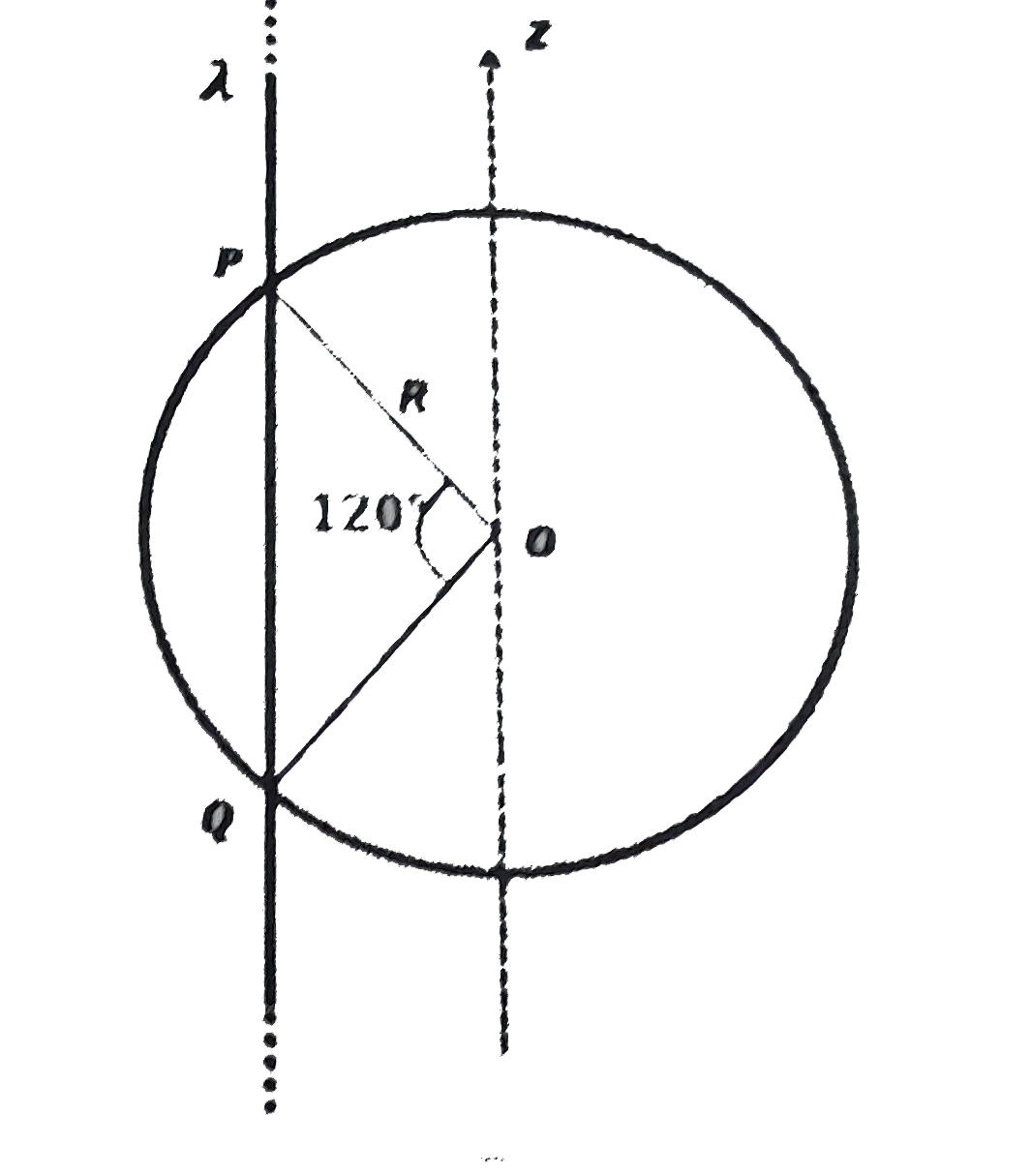An infinitely long thin non-conduction wire is parallel to the z-axis and carries a uniform line charge density λ. It pierces a thin non-conducting spherical shell of radius r in such a way that that the are PQ subtends an angle 120∘ at the centre O of the spherical shell, as shown in the figure. The permittivity of free space is ε0. which of the following statements is (are) true ?

The electric flux through the shell is √3Rλ/ε0
The Z-component of the electric field is zero at all the points on the surface of the shell
The electric flux through the shell is √2Rλ/ε0
The electric field is normal to the surface of the shell at all points.
The correct Answer is:A, B
Qenc=λ√3R
ϕ−Qencε0=√3λRε0
Infinitely long line charge is parallel to Z-axis, hence its electric field being radially outwards becomes perpendicular to Z-axis everywhere.
Topper's Solved these Questions
- ELECTRIC CHARGES AND FIELDS Book:MODERN PUBLICATIONChapter:ELECTRIC CHARGES AND FIELDS Exercise:COMPETITION FILE ( Objective Question (D.MCQ) Passage )
Explore 10 Videos
- ELECTRIC CHARGES AND FIELDS Book:MODERN PUBLICATIONChapter:ELECTRIC CHARGES AND FIELDS Exercise:COMPETITION FILE ( Objective Question (Assertion Reason ) )
Explore 15 Videos
- ELECTRIC CHARGES AND FIELDS Book:MODERN PUBLICATIONChapter:ELECTRIC CHARGES AND FIELDS Exercise:COMPETITION FILE ( Objective Question (BC.MCQ))
Explore 10 Videos
- DUAL NATURE OF RADIATION AND MATTER Book:MODERN PUBLICATIONChapter:DUAL NATURE OF RADIATION AND MATTER Exercise:CHAPTER PRACTICE TEST
Explore 15 Videos
- ELECTROMAGNETIC INDUCTIONBook:MODERN PUBLICATIONChapter:ELECTROMAGNETIC INDUCTIONExercise:CHAPTER PRACTICE TEST FOR BOARD EXAMINATION
Explore 14 Videos
Similar Questions
A point charge +q is placed at the centre of a conducting spherical shell of inner radius a and outer radius b. Find the charge appearing on the inner and outer surface of the shell.
View SolutionA point charge Q is placed inside a conducting spherical shell of inner radius 3R and outer radius 5R at a distance R from the centre of the shell. The electric potential at the centre of the shell will be
View Solution
Knowledge Check
A non-conducting spherical shell of radius R surrounds a point charge q (q at center). The electric flux through a cap of the shell of half angle θ is:
A2πqθ∈0Bq2∈0(1−cosθ)Cq(2θ)4π∈0Dqθ2π∈0A thin walled spherical conducting shells S of radius R is given charge Q,the same amount of charge is also placed at its centre C.Which of the following statements are correct.
AOn the outer surface of S, the charge density is Q/2πR2.BThe electric field is zero at all points inside S.CAt a point just outside S, the electric field is double the field at a point just inside S in the cavity.DAt any point inside S (i.e., within its cavity), the electric field is inversely proportional to the square of its distance from C.A charge Q is placed at the centre of a spherical conducting shell. Choose the correct option.
AOnly −Q will appear on its inner surfaceBOnly +Q will appear on its outer surfaceCA charge −Q will appear on its surface and +Q on its outer surfaceDA charge +Q will appear on its inner surface and −Q on its outer surface
A uniformly charged thin conducting spherical shell of radius R and charge q is rotated with constant angular velocity ω about a diameter. The magnetic dipole moment of the system is
View SolutionCharge Induction In Metal Cavities|Combination Of Conducting Spherical Shell
View SolutionA point charge is placed at a distance 2 a from the centre of a thin conducting uncharged spherical shell A of radius 'a' as shown in the figure.Then the charge on the shell will be
View SolutionA point charge is placed at a distance 2 a from the centre of a thin conducting uncharged spherical shell A of radius 'a' as shown in the figure.Then the charge on the shell will be
View SolutionA thin spherical conducting shell of radius R has a charge q. Another charge Q is placed at the centre of the shell. The electrostatic potential at a point P a distance R2 from the centre of the shell is
View Solution

